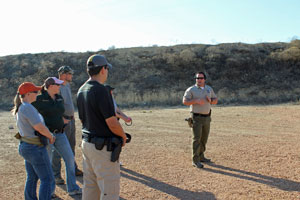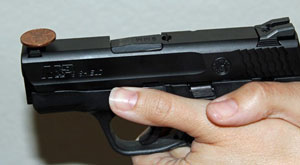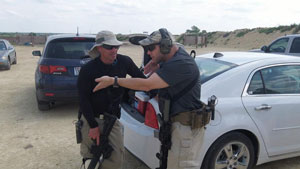Training. What does that mean to you? Does it mean going to the local gun range and shooting a box of ammo with the indication of success being the center of the target shot out? Or does it mean learning skills that relate to the real-life dynamics of fighting for your life? Sadly, most gun owners I talk to say the former. The sad truth is, that false sense of security could prove fatal or tragic for innocent bystanders if those individuals ever encountered a true life-or-death situation where a firearm had to be used. Due to false myths and the lack of truly understanding the hows and whys of what fighting for your life entails, people simply don’t know. Let’s look at what true training should entail, so we can be better informed on what we should be doing.
Contrary to what Hollywood movies show, bodies do not fly through the air when hit. There is no such thing as calmly raising the handgun with one hand and firing a single shot to the head to end the threat, while beating the other guy senseless with your other hand. In most real-life cases, the body will continue to move toward you until vital organs fail to function, and all the while you will most likely be changing your pants due to the body’s natural response to a life-or-death situation. This is where training becomes pivotal. If your training works with those natural and uncontrollable responses, it can dictate the outcome of a potentially bad situation. One cannot control body responses such as flinching, blood flow to vital organs for that fight-or-flight response, adrenaline dumps, etc. If your training does not incorporate those natural reactions that our bodies will exhibit in a true dynamic situation, you are already way behind the curve.
Let’s Get Real
How do we incorporate that into our training? Safety always has to come first, but that does not mean your training should not be taxing. Pushing your physical and mental limits are paramount to building that Rolodex of knowledge and improving core fundamental skill sets. Notice I said improving core fundamentals. The core fundamentals of shooting are where all training should start. Stance, grip, extension, sight picture, and trigger mechanics are the bases we build upon. People often consider themselves advanced shooters because they can shoot out the center of a bullseye target or because they have been shooting all their lives.

Getting quality accredited training goes a long way toward being ready for the fight.
In reality, advanced shooters are simply shooters who continually attempt to master the core fundamentals and can apply them to advanced scenarios. But the core fundamentals have to incorporate those natural body responses. For example, when under stress, shooting with one eye open focusing on the front post sight is not going to happen due to the body’s response to process as much information as possible, which causes both eyes to “bug out” of the head. When shooting at close proximity under stress, you will more than likely not even see your front post as you empty your full magazine. And you’ll think you shot only four or five rounds into the threat. In addition, you will be totally focused on the threat and may not realize that your kid’s room or bystanders are nearby, which is important to recognize.

Don’t think you are ready for a real-life encounter simply because you can hit a bullseye at seven yards without any simulated stress.
Pulling the trigger is the easy part of firing a handgun when under stress. The psychological and physiological aspects of shooting are the hard parts, and some of them we have no control over. Since no two incidents are alike, we have to include training that involves problem solving while under stress. Violent encounters where a gun is employed as a last resort are usually unexpected, chaotic, and over within a few seconds. That means a lot of cognitive information has to be processed in a short time before deciding to pull the trigger. Threat identification, shoot/no-shoot decisions, foreground/background issues, environmental conditions, reaction time, and confidence in your skill sets are a few of the concerns. Simple target shooting on a range does not address these core aspects of a real-life incident.
Sample Drill
That is why our training should encompass the realities of the real world. Training should be physically and mentally challenging. This can mean simple things like incorporating a timer and/or physical exertion into fundamental skill sets, and range drills that include problem-solving scenarios. “My range doesn’t allow such and such” is not an excuse. If there are restrictions at your range, you have to get creative.

Realistic training means training in methods congruent to what happens in real life. Zombies may be fun, but make your training count and maximize your money and time at the range. Photo: courtesy www.zombieammo.com
Here is a perfect example. Set up a target, preferably one that is lifelike and imitates a true threat like an individual holding a gun. On the target, draw a 2-inch circle in each corner and give each circle a value like A, B, C, and D. Take a piece of paper and tear multiple pieces and write down varying orders like M (center Mass of the target), B, D, A, and C on one piece and change the order up on the remaining pieces. Mix up the pieces and randomly pick one and memorize the order for five seconds. Now induce a simulated body response by running in place for 60 seconds, doing pushups or jumping jacks, or something else that gets your heart rate up and you breathing hard. Then step up and try to shoot the memorized order that was drawn as accurately and as fast as possible for time.
A simple drill like this accomplishes our goal of incorporating the physical and mental aspects that we discussed earlier. We induce a body response through exercise and a cognitive process through attempting to complete the memorized order that was randomly picked, while simultaneously solidifying our core shooting fundamentals. This is just one way to maximize your training at a range that limits movement.
Probability vs Possibility
Also be sure you’re training for probability, not possibility. Train for scenarios that have a realistic probability of occurring in your daily life. Anything is possible, and we cannot possibly train for everything. But we can train for instances that have a high probability depending on your lifestyle. If you work downtown in a major city and have to park in a remote dark area that lacks security, your odds of encountering a potential threat are greater than if you park in a well-lit and secure area. You want to incorporate some training that deals with low light, obstacles, addressing extra issues such as carrying a briefcase or purse, your method of concealed carry, and so on.

Train for scenarios that are probable in your daily life.
Your best choice is to train with an accredited instructor or program that includes these aspects in the curriculum. When looking at an instructor or program, ask yourself if the class is applicable to what you are training for and if the skill sets being taught are supported with logic and facts. If you hear the phrase “That’s just how we do it” as an answer, I suggest finding a more reputable program or instructor. Any reputable instructor should be able to back up what s/he is teaching with relevant factual information. Just because it is “tacti-cool” doesn’t mean it’s relevant to saving your rear end in real life. In fact, it could get you killed. Do your homework when searching out classes or programs. Ask for references, check reviews, and look at credentials before spending your money.
No-Excuse Zone
Just because you cannot attend a class or make it to the range does not give you an excuse not to train realistically. A lot of what is done at the range can be done with dry-fire practice.

Dry-fire practice is a great training tool that helps keep core fundamentals sharp.
Verify the gun is safe and unloaded, make sure all ammunition is in another room, continue to practice the fundamental gun safety rules, and you can have productive dry-fire practice that reflects dynamic range training. You can practice basics such as drawing from the holster, sight-alignment drills, trigger-press fundamentals … the list can go on and on.
Take a step back and give serious consideration to how you train. As a responsible firearms owner, raise the minimum standard that is currently being accepted in training. Get training that maximizes your money and time. Since both are limited for most of us, treat your training as if your life depended on it. For the majority of us, if we ever have to protect ourselves or others with a firearm, we only get one chance. Make it count.






Wow, good stuff. Thank you
Always push your comfort level in order to get better at the things we don't do well. Be sure to stay safe when doing so though.
I don't think you can ever get too much training. Every time we go to the range my partner and I use multiple targets, and the one doing the timing calls out what shot to take.
Excellent advice! This is a great self confidence moral booster!
You are correct, that false sense of security can be a big liability. I always tell clients that if you choose to carry, go above and beyond the minimum and never stop learning.
Excellent advice Mr. Vernon, I advocate additional training in all my Basic Pistol Classes. For what ever reason many don't go beyond the Basic Course, yet consider themselves trained enough to carry daily.
Wow, good stuff. Thank you
Always push your comfort level in order to get better at the things we don't do well. Be sure to stay safe when doing so though.
I don't think you can ever get too much training. Every time we go to the range my partner and I use multiple targets, and the one doing the timing calls out what shot to take.
Excellent advice! This is a great self confidence moral booster!